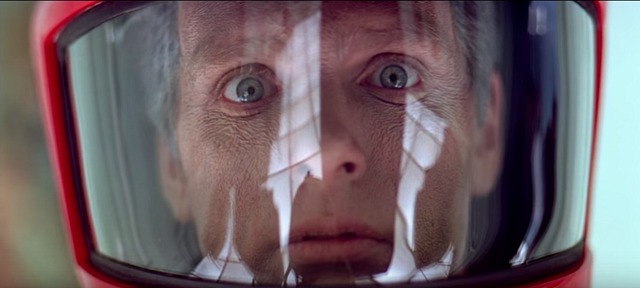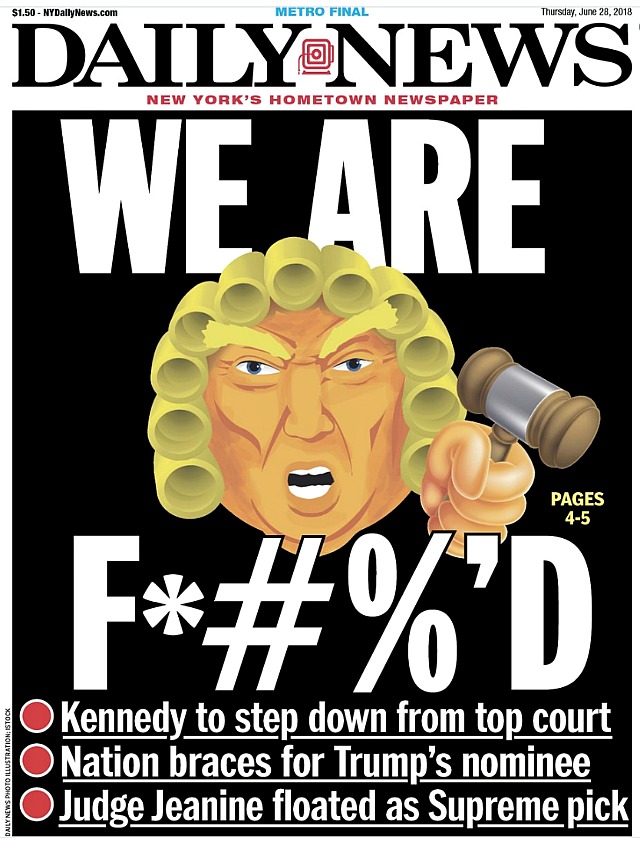My heart goes out to the family, friends and colleagues of the five victims of today’s Capitol Gazette shooting — Gerald Fischman, Rob Hiaasen, John McNamara, Wendi Winters (all editorial) and sales assistant Rebecca Smith. Another ghastly tragedy and all too common, as we’re all sick of acknowledging. Another lone gunman, reportedly driven by rage and resentment. (He reportedly felt that the Gazette had misreported a harassment compliant against him by a former high-school classmate.)
Day: June 28, 2018
WHE Trailer Shows “2001” 4K Bluray Is Nolan Version!
On 6.21.18 Warner Home Entertainment posted a trailer for the forthcoming 4K Bluray of 2001: A Space Odyssey, which will street on 10.30. And it’s horrifying! Because the yellowish-teal color tint in this trailer is obviously the same color tint as the currently-playing Chris Nolan version of 2001. Watch it and tell me what you think.
It seems obvious (and please tell me how I could possibly be wrong about this) that the 6.21 4K trailer is proof that the yellow-teal Nolan version has been used as the basis for the forthcoming 2001 4K Bluray.
This means that WHE wasn’t kidding when an official press release (also issued on 6.21) stated that “for the first time since the original release [of 2001 in April 1968], new 70mm prints were struck from pristine printing elements made from the original camera negative” — i.e., the Nolan version. “A longtime admirer of the late American auteur, Christopher Nolan worked closely with the team at Warner Bros. Pictures throughout the mastering process.
“Building on the work done for the new 70mm prints, the 4K UHD with HDR presentation was mastered from the 65mm original camera negative,” the press release said. “The 4K UHD also includes both a remixed and restored 5.1 DTS-HD master audio track, as well as the original 1968 6-track theatrical audio mix.”

Frame capture from 2007 Bluray of 2001: A Space Odyssey.
 Same image copied from WHE trailer for forthcoming 4K Bluray, which contains the same colors and specificity seen in the Chris Nolan version now in theatres.
Same image copied from WHE trailer for forthcoming 4K Bluray, which contains the same colors and specificity seen in the Chris Nolan version now in theatres.Posted on 6.21.18: “The key words, obviously, are ‘building on the work done for the new [Nolan-approved] 70mm prints.’ Question: If color-timer Leon Vitali told me that “the 4K has more clarity and sharpness and detail” than the 70mm Nolan version (and he did tell me this), why would the WHE people indicate that the Nolan nostalgia version and the 4K version are close relations if not more or less the same?
“One could surmise that Vitali’s 4K version was one thing back in April, but that Nolan has recently stuck his nose into the mastering of the 4K and that things have changed for the worse. I’m not saying he has stuck his nose into the process, but the WHE press release certainly suggests this.”
Unless the person who presided over the making of the 2001 4K trailer is deranged or incompetent, there’s very little ambiguity about this now. WHE’s trailer for the 2001 4K proves that the Nolan nostalgia version (i.e., a replica of the film Nolan saw on 70mm when he was 7 or 8 years old) and the 4K Bluray version are indeed one and the same. So Nolan did in fact stick his nose into the 4K Bluray mastering and changed the look of it.
Please consider two seemingly crucial factors about Nolan and his perspective on Stanley Kubrick‘s 1968 classic.
One, it has been claimed in some quarters that Nolan is red-green colorblind. (I’m looking for definitive sources on this but here, for now, is source A — here is source B.)
And two, Nolan has stated that he wanted to create an “unrestored” 70mm version to look like a 70mm version he saw with his father in Leicester Square when he was 7 or 8 years old. Except Nolan was born on 7.30.70, or more than two years after 2001 premiered in the big cities. The 2001 Nolan saw with his dad in Leicester Square presumably screened in ’77 or ’78, so he didn’t see the original roadshow version.
Please once again consider a comparison trailer (posted on 4.24.18 by Krishna Ramesh Kumar) that presented the differences in color in the 2007 Bluray of 2001 vs. the then-forthcoming Nolan version that premiered in Cannes. It showed that the yellowish-teal colors in the Nolan version were quite different than the 2007 Bluray colors.
I believe that WHE’s decision to kowtow to Nolan’s yellow-teal vision of 2001 is nothing short of vandalism. I think it’s a flat-out tragedy. I think Leon Vitali, who did the color timing on an earlier version of the 4K Bluray and who is supposed to be the keeper of the Kubrick flame, needs to stand up and say “no, this is wrong…the Chris Nolan nostalgia version is not how 2001 should look.” I think anyone who knows what 2001 should look like should speak up also. This is horrific.
Another Mark & Peter Show
Post-posted, 9:28 pm: A sincere apology is hereby conveyed to a journalist-critic because he believes I’ve dishonored his family. I repeated in this short piece my longstanding dislike of martial-arts action scenes and the whole Asian martial-arts genre. But rather than quibble with the guy I hope he’ll accept this apology. What I wrote was simply an opinion about a certain kind of fare. An expression of aesthetic disdain that I’ve conveyed many times. (I also loathe Bollywood films.) I’m nonetheless sorry for hurting the journalist-critic’s feelings and those of his family.
Earlier: Mile 22 (STX, 8.17), the latest Peter Berg-Mark Wahlberg action flick, looks pretty good. Generic but efficient. Back in the ’90s and early aughts Jerry Bruckheimer and Joel Silver used to own this genre. Their names were synonymous with this kind of thing. Remember the Black Hawk Down hoopla? Now it’s “eh, Berg and Wahlberg again…fine.”
I tend to pull back when I spot an Asian actor, stuntman, fight choreographer and martial artist in the cast. Films of this sort have to appeal to the Asian market, of course, but I really don’t care for martial-arts fight scenes. I never have.
Sidenote: When I first heard this title I thought of “Mila 18,” a 1961 Leon Uris novel abut the Warsaw Uprising. In August 2017 Harvey Weinstein announced that he’d produce a film based on the novel, and that he himself would direct. But that went south, of course.
Worst Drivers in the World
To me the worst drivers are the pokeys — the ones who react to problems and obstructions in an extra-slow, extra-cautious fashion. Most of the time I just steer my rumbling, gurgling Yamaha (doop-doop-doop, dungh-dungh-duhgh) around them, but when I’m driving the Mini-Cooper they can be infuriating. When you’re on two-wheels you can always spot them fairly easily — I actually call them trouble-makers. Because they actually make things miserable for other drivers.
Identifying trait #1: A pokey will sometimes idle six or eight feet behind the white barrier line at a traffic light. They stay away from the white line because the idea of venturing into traffic intimidates them, and so hanging back feels safe and soothing.
Identifying trait #2: When the light turns green and pokeys are in the left-turn lane, they won’t nudge their way into the crossroads like any good driver — they’ll wait at the white line like old ladies (sometimes because they are old ladies) until the coast is totally clear.
Identifying trait #3: When approaching a car on a four-lane street that’s partly obstructing the right lane (i.e., sticking out just a bit during an attempt to parallel park), the pokeys will always stop dead and wait for the car-parker to finish the job. They’ll never look behind them and scoot around the obstructing auto — a task that usually involves going into the left lane just a little bit. Pokeys are too chicken to do this, and this is why in a fair and just after-life they would burn in hell.
Identifying trait #4: When pokeys are looking for a place to park on a residential street, they always slow down to 5 or 10 mph but without arm-signalling cars behind them to go around. It’s always me me me me me me me me, etc.
Identifying trait #5: When they see a curbside parking spot pokeys always pull in front and then back into it, thereby maximizing the obstruction time for other cars. They never just duck into the space hood-first and then wiggle around, like I do when I’m driving the Mini.
Instant Abrasion
Josephine Decker‘s Madeline’s Madeline (Oscilloscope, 8.10) was high on my Sundance ’18 list, due to the recommendations of two or three critic friends. I tried to catch it, but the scheduling didn’t work out. It currently has a 93% Rotten Tomatoes rating — great. But the trailer, “directed” by Winston Hacking, totally rubs me the wrong way. It’s like chalk on a blackboard. I’m now half-persuaded that I’m going to despise the film.
Could Gregory Ellwood‘s 1.15.18 Playlist review be a warning? “Madeline’s Madeline is certainly not for everyone,” he wrote, “and while that might not sound like a ringing endorsement, it’s solicited in the context that the film is an experience that will test some viewers’ patience, as all good art often does.” The headliners are Helena Howard, Miranda July and Molly Parker.
Not A.O. Scott’s Fault — I Did This To Myself
N.Y. Times critic A.O. Scott has become a pet peeve around these parts. Last January he posted “My Woody Allen Problem,” which all but ignored the glaring doubts and ambiguities coloring the charges against Allen, especially since the 5.23. posting of Moses Farrow’s essay, which pretty much closed to the book on the case. And last night he darkened my brow by persuading me to watch Lover Come Back (’61), the crusty, throroughly constipated Rock Hudson-Doris Day sex comedy. Scott didn’t actually steer me wrong last night — I happened to watch a 8.4.09 N.Y. Times “Critics Pics” essay in which Scott praised it to the heavens.
Lover Come Back is strangely “funny” to Scott, and presumably to others. Or it used to be. It helps if you can tolerate broad, wafer-thin farce, which leaves me out. Or if you’re down with an arch parody of middle-class sexual attitudes as they existed in the early JFK years, but there isn’t a single line or situation that reflects the human experience as I know it. To really get Lover Come Back you probably need to be coming from a place of straight-jacketed middle class propriety and sexual suppression — then it’s a laugh riot.
All I can tell you is that I didn’t so much as crack a smile, much less chuckle or guffaw. There are two or three lines that aren’t half bad, one about “seaweed jockey shorts” and another from one hospital orderly to another: “Now that’s what I call cutting it close.”
I guess it’s not really A.O. Scott‘s fault — it’s mine. I did it. I found Lover Come Back on Amazon Prime and watched it of my own free will.
Tail of West Hollywood

I’d been thinking about attaching a foxtail to the Yamaha Majesty for years. For some reason I did nothing, and for some reason I suddenly jumped on the case last week. The tail arrived yesterday. Done.
Rage and Defeatism
“Justice Anthony Kennedy’s retirement is crushing. It sends a stark message to the tens of millions of Americans who have long turned to the court for the vindication of many of their most cherished rights and protections: Look somewhere else. That place is the ballot box. So show up and vote. In the absence of a Supreme Court majority that will reliably protect human dignity, universal equality and women’s right to control their own bodies, it is up to Americans who cherish these values to elect politicians at every level of government who share them.” — N.Y. Times editorial, posted on 6.27.

“Piercingly Disturbing and Riveting”
For the first time in months I’m feeling a profound kinship with Variety‘s Kris Tapley, who’s blocked me on Twitter and is always scowling and avoiding eye contact at press gatherings. I’m saying this because Tapley shares my admiration for Stefano Sollima and Taylor Sheridan‘s Sicario: Day of the Soldado (Columbia, 6.29). He recently spoke with costars Josh Brolin and Benicio del Toro.
“Movie’s great,” Tapley says to Del Toro as they begin. “Might be better than last time…I love it.” Del Toro’s Alejando Gillick character was cold and hollowed out and vengeance-driven in Sicario, Del Toro explains, but in Soldado he experiences “an awakening of a conscience [that] brings humanity back to the character.”
The Guardian‘s Peter Bradshaw: “This movie is just so piercingly disturbing and riveting. There is something of Kathryn Bigelow in the night-vision scenes, Michael Mann in the large-calibre weaponry and high-speed convoys, and something also of the Coens’ No Country for Old Men, which like this film stars Josh Brolin. And as a grandiose, episodic story of evil, it has something of Christopher Nolan’s Batman films. It is a violent action noir, rocket-fuelled with its own reckless cynicism.”
The Telegraph‘s Robbie Colin: “Quite honestly, it’s a thrill to see a mid-budget thriller crafted along such mature, unflashy lines — not least one with a right-leaning political bent, which hasn’t lately been much of a signal of aesthetic finesse, give or take the odd American Sniper or Hacksaw Ridge. Both Brolin and Del Toro play classic right-wing heroes — they’re grizzled predators whose hunting ranges uneasily intersect, each prepared to make snap judgements that run against their orders, providing it’s for the best as they see it.

